
Guests
- LaDonna Brave Bull AllardStanding Rock Sioux tribal historian.
We continue our coverage of the standoff at Standing Rock, where on Saturday the Dakota Access pipeline company unleashed dogs and pepper spray on Native Americans seeking to protect a sacred tribal burial site from destruction. Just a few hours before the attack, Democracy Now! interviewed Standing Rock Sioux tribal historian LaDonna Brave Bull Allard about another attack against her tribe more than 150 years ago. On September 3, 1863, the U.S. Army massacred more than 300 members of the Standing Rock Sioux Tribe in what became known as the Whitestone massacre. LaDonna Brave Bull Allard is also one of the founders of the Sacred Stone camp, launched on her land on April 1 to resist the Dakota Access pipeline.
Transcript
NERMEEN SHAIKH: We turn now to the standoff at Standing Rock. On Saturday, September 3rd, the Dakota Access pipeline company unleashed dogs and pepper spray on Native Americans seeking to protect a sacred tribal burial site from destruction.
WATER PROTECTOR 1: This guy maced me in the face. Look, it’s all over my sunglasses. Just maced me in the face.
WATER PROTECTOR 2: These people are just threatening all of us with these dogs. And she, that woman over there, she was charging, and it bit somebody right in the face.
AMY GOODMAN: The dog has blood in its nose and its mouth.
WATER PROTECTOR 2: And she’s still standing here threatening us.
AMY GOODMAN: Why are you letting their—her dog go after the protesters? It’s covered in blood!
VICTOR PUERTAS: Over there, with that dog. I was like walking. Throwed the dog on me and straight, even without any warning. You know? Look at this. Look at this.
AMY GOODMAN: That dog bit you?
VICTOR PUERTAS: Yeah, the dog did it, you know? Look at this. It’s there. It’s all bleeding.
AMY GOODMAN: To see that full report of Democracy Now!, which has gone viral on Facebook, more than 11 million hits, go to democracynow.org.
Only a few hours before the attack, we sat down with Standing Rock Sioux tribal historian LaDonna Brave Bull Allard to speak about another attack against her tribe. This was more than 150 years ago. On September 3rd, 1863, the U.S. Army massacred more than 300 members of the Standing Rock Sioux Tribe in what became known as the Whitestone massacre. LaDonna Brave Bull Allard is not only the tribal historian, she’s also one of the founders of the Sacred Stone Camp, launched on her land April 1st to resist the Dakota Access pipeline. We met her this past Saturday on her property at the Sacred Stone Camp.
AMY GOODMAN: We just came from the main camp, and there was a yellow helicopter hovering overhead. What about the militarization of the area, LaDonna?
LADONNA BRAVE BULL ALLARD: So, from the time we started the camp, April 1st, the helicopters and the planes, low-flying planes, have been here almost daily on a routine. We have the drones that come in in the evening. We know they are in full array, because they come in at night. They come through the whole camp. And when the people were gathering, the planes were numerous here, the helicopters are numerous here. We have been under surveillance. Right now, today, we have four large boats out in the river over by the access site. And, of course, with the blockades that we are suffering, the governor of North Dakota wants to put an economic condition on us. If he stops the economics here—
AMY GOODMAN: You mean like an embargo?
LADONNA BRAVE BULL ALLARD: Yes, to have the roads blocked off.
AMY GOODMAN: Oh, an economic blockade.
LADONNA BRAVE BULL ALLARD: Yeah. So the roads are blocked off, and nobody is allowed access down here. So, we have to take an alternate route to make it here. We have police everywhere, that are racial-profiling, because a non-Indian can go through, we cannot. And everybody here understands the drones. So what we’ve been doing is recording the times and dates of each drone and each helicopter as they come through. And we already know their patterns. They’ve been here so much. And we know they’re photographing the whole area. When we had the road grader down here trying to grade the road, they were like massive. The helicopters, the planes and the drones were all sent in, all to see: What are those Indians doing? Although we were just fixing the road.
AMY GOODMAN: Why don’t we sit down and talk about your family history here? Your family has been here for generations?
LADONNA BRAVE BULL ALLARD: Yes, my family has been here since 1873, when we were brought across from the east side of the river. My name is LaDonna Brave Bull Allard. My real name is Ta Maka Waste Win, Her Good Earth Woman. I am Ihunktonwan, Hunkpatina and Pabaska Dakota on my father’s side. I am Hunkpapa, Sihasapa and Oglala Lakota on my mother’s side. So, I’m Lakota-Dakota, but I was raised Dakota. It’s—I know the outside world probably doesn’t understand that, but we understand it here. And I am an enrolled member of the Standing Rock Sioux Tribe. I am the historian and genealogist. I work for Tribal Historic Preservation Office as Section 106 coordinator.
AMY GOODMAN: We’re actually speaking on September 3rd, the weekend of Labor Day. And this is a very important anniversary.
LADONNA BRAVE BULL ALLARD: I didn’t even know it was Labor Day. This is September 3rd. A hundred and fifty-three years ago—fifty-two years ago, the Whitestone massacre happened, which the people in this community, the Cannon Ball community, are from, descendants of that massacre. We are the survivors of that massacre. One of the things that, you know, I always say is, this massacre happened, America forgot they killed us. And we have just—spending this time trying to figure out how to survive. So, we were the wrong Indians that they killed at that time. The Dakota Wars were happening in 1863. And so the government put up these armed forces to go after the Isanti, the Santee, and so they put this military action together.
On the morning of September 3rd, our people were gathered, as we do every year at this time. We gather because it’s harvest time. The fruit and vegetables are ready. It is a time when we are doing the buffalo call, and we have ceremonies to call the buffaloes for the people to come to hunt, so that we can prepare the meat for winter. So this is what was happening at Whitestone at that time. And so, we have a large gathering of 4,000 people. And I think that’s kind of unique. There’s almost 4,000 people here. And so, we had all of these communities coming in together to go into this trade. And as people are preparing buffalo hides and getting dry meat ready, they are also visiting, making relatives, having marriages. All of these things are happening in this camp. And so, they say the soldiers are coming. And our leaders said, “We have never had an argument with the white people. We have only been at peace. We do not have a treaty with them.” And so, our people got together and said, “We heard that if you take a white flag, they will honor that to talk with us.” So they took a white flour sack, and they put it on a stick, and our leaders all went out into the soldiers to say they wanted to talk.
AMY GOODMAN: Your grandfather was one of them?
LADONNA BRAVE BULL ALLARD: Yes. So my grandfather was a medicine man. His name was Tatanka Ohikita, Brave Buffalo. So, Brave Buffalo was among them, with the chiefs. They went out to talk to the soldiers. The soldiers surrounded them and took them as a prisoners of war and cordoned them off from their people. And so, the people were watching. And just like we are taught, automatically, if there is an enemy coming in, we gather all the children in the center, all the women. People were starting to tear down their lodges. People were trying to move in the chaos. So the first things the women did is they tied the babies to the dogs, they tied the children to the horses, and they shooed the dogs and the horses out of the camp. And then they gathered what they could, and they started running.
Well, at the camp, at Whitestone, they came down, and there’s this ravine. And so the people started making their way down to the ravine. And it’s kind of bizarre to us that these soldiers came in just as the sun was going down. And so, they were going to the ravine. And the soldiers came on this top of the ravine and this top of the ravine, and started shooting the women and children in the ravine. And one of the—one of our soldiers went out in front and broke the open, so that people can continue running. So, as night is falling, my grandma, Nape Hota Win, Grey Hand, she was running, and, she said, all of a sudden she had a sharp pain in her hip, and she fell down.
AMY GOODMAN: She was a child.
LADONNA BRAVE BULL ALLARD: Yeah, she was nine years old. And she laid on that ground, and she spent the night calling, “Ina! Ina!” or “Mom! Mom!” with no answer. Everywhere, she could hear the crying and screams, the songs of people dying. And as the sun came over and she could see everything that was happening, two of the soldiers came and grabbed her and threw her in the back of a buckboard. I am unsure of why that happened, because they went around, and they killed the other wounded. Why they did not kill my grandmother, I do not know.
So she laid in the buckboard as she watched the soldiers come and start killing the dogs and the babies, killing the horses, killing the wounded. They gathered up all of our property—the tents, the meat, the hides, everything we own. And we had one section of soldiers sitting down there poking holes in the bottom of our pots. And they gathered all that, and they started this great big fire, burning all our food, our homes, everything. They said that there was so much buffalo meat that they burned, that tallow ran down like rivers out into the creeks. And the people ran. For three to four days they ran, as the soldiers continued to chase and kill them. Part of our people came across here. This used to be a narrow crossing, where they crossed. And they crossed over on this side of the river to get from the soldiers.
And one of the things that we always say at this massacre is they forgot they killed us, and we weren’t even the right Indians. So, they rounded up our chiefs. They escorted them, force-marched them to the river. They put them on boats, and they took the people to the prisoner-of-war camps down in Crow Creek. And my grandmother was one of them, that went to the prisoner-of-war camps. And you would have to go do the research about the horrifying things that happened at the prisoner-of-war camps.
But they released us in 1870, and we came back to the east side of the river and started our homes. The Army came in, in 1873, and rounded up our people and brought us to this side of the river. And when they did that, we figured, OK, we can start our lives. We can do this again. So our people started the communities. They started living again. And my grandma told me that in the 1940s we were self-sufficient. We planted our own gardens. We owned our own cattle. Everybody and every community, we owned our own homes.
And then, in 1948, the government made the Pick-Sloan Act, which is the Army Corps. And the Army Corps decided to build a dam above us and build a dam below us. So, Oahe Dam is below us, Sakakawea Dam is above us. And they designated us as a reservoir. And so, they came, and they moved our people out of their homes. They took our homes. They moved them up into the communities and put in these low-income housing. And—
AMY GOODMAN: You lost millions of acres?
LADONNA BRAVE BULL ALLARD: Yes. We lost—
AMY GOODMAN: From the reservation.
LADONNA BRAVE BULL ALLARD: We lost whole communities. Whole communities had to move. And so, I think, with the people—and, you know, somebody said, “Well, did your grandparents go?” No, I went through this. I lived here. I remember the trees and the forest. I remember coming down and collecting water to drink from this river. We would come down and haul water up to the house. We drank this water. We lived with this water. We had huge gardens here. This is me. This is not something long time ago. This is me who lived through this.
And so, they came, and they flooded it. They took all our trees, all our forest, when they flooded us. They took all of our medicines, our plants, the things that we survive in. And so, if you talk to the people that are my age and older, you can hear the grief in our voice, because we still grieve for the loss of this land. And they moved us on top of the hills, where it is more of a clay-based soil, so we could no longer grow gardens, we could no longer plant trees, we could no longer do the things that we did.
Then they put them in communities where people were not used to living. And so we have these housing projects now, of low-income housing, where they could not own. So our communities changed drastically. But we figured, “We can do this. We can survive.” So everybody came. At that time—and I don’t know if people understand, at that time, when the Army Corps came in, we had businesses. We had stores. We have restaurants. We had—the Army Corps and the government bought out all these businesses, and they never came back and redeveloped again. So we don’t have infrastructure anymore. We don’t have the gas stations and the stores and stuff. We’ve got to travel to Bismarck, Mandan or to Mobridge. So, they took our economic infrastructure from us.
So, we started again. Indian people, we have a system. We’re communal people, so everybody shares what we have. And so, we started again. And so, we’re trying to survive. We’re trying to live our lives. We are very proud of the fact that our people have fought in all the wars. Each of us, every year, get up and stand up and say our families’ military history. My grandfather was a Lakota code talker. He won the Silver Medal for World War I, when we were not U.S. citizens. My uncle John is World War II. My father is Korean War. My brothers are Vietnam. And all of my cousins are in every action that has happened thereafter. We hold some of the highest medals of honor. And so, we thought we were doing the best we can with America.
And so, when they told us that they were putting this pipeline in, but refusing to acknowledge us—if you look at the Dakota Access maps, they don’t even acknowledge our nation. We are not black—we are not blacked out, like some people make maps, and they do the reservation boundaries. We’re not even in there. They said they did not have to consult with us. That pipeline is 500 feet from our reservation line. When that pipeline breaks—and it will break—it will hit Early Head Start children in two seconds. It will take out our elementary in five seconds. In 45 minutes, it will take out our major water intake that feeds water to all the people here.
I don’t understand why we are expendable in America. I keep telling people, we do our best. We have always been here. This is our land. Why should we fight to live on our own land? Why should we have to do that over and over again? We start our lives. We do our best to live. Why? I would never hurt anybody. I have always done my best to do good things in my community. Why can’t they just let us live? We love this land. And half of the time I feel bad, because they make us feel bad for loving this land.
But most important, we love the water. Every year, our people sacrifice. We go four days without drinking water, so that it reminds us how important this water is. And I ask everybody: Do you go four days without water? What happens to your body on that third day? Your body starts shutting down. So, we remind ourselves every day how important. We say mni wiconi, water of life. Every time we drink water, we say mni wiconi, water of life. We cannot live without water. So I don’t understand why America doesn’t understand how important water is. So we have no choice. We have to stand. No matter what happens, we have to stand to save the water.
AMY GOODMAN: LaDonna Brave Bull Allard, tribal historian for the Standing Rock Sioux, speaking to us on the morning of September 3rd, the day the Dakota Access company unleashed dogs and pepper spray against Native American land defenders, biting a number of them. It was also the 153rd anniversary of the Whitestone massacre, when the U.S. Army killed 300 members of the Standing Rock Sioux Nation.
That does it for our show. Nermeen Shaikh and I will be speaking at the Toronto International Film Festival this Friday night and Saturday. Check our website, democracynow.org, for details.

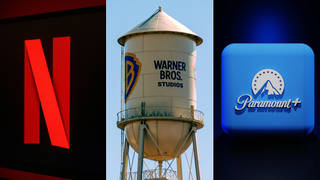
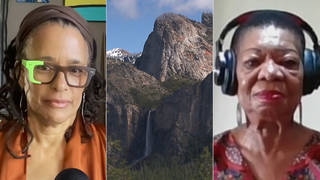
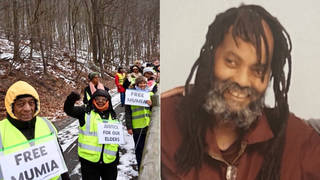
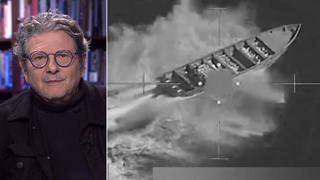





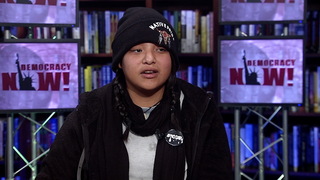

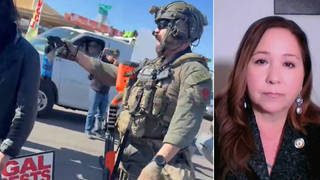
Media Options